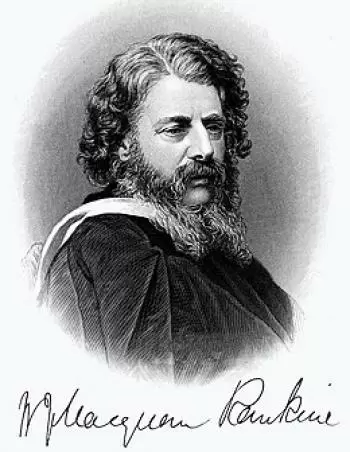
William John Macquorn Rankine (Edinburgh, July 5, 1820 - Glasgow, December 24, 1872) was a Scottish engineer and physicist. He had very different interests; in his youth he was interested in botany, music theory and number theory and in his later years in mathematics and technology.
Along with Rudolf Clausius and William Thomson, he is among the founders of thermodynamics. He also developed the theory behind the steam engine, introduced concepts such as kinetic and potential energy, and investigated shock waves and metal fatigue.
William Rankine: biography and life
William John Macquorn Rankine was the son of professional soldier and later civil engineer David Rankine and the daughter of Glasgow banker Barbara Grahame. He attended grammar school at Ayr and Glasgow only a few years after the family moved there in 1830.
After reading, at the age of fourteen, Isaac Newton's greatest work, Principia Mathematica (1687) in Latin, he became interested in physics.
At the age of sixteen, in 1836, he began to study natural science at the University of Edinburgh, where he was taught, among other things, natural philosophy under James David Forbes and natural history under Robert Jameson.
In 1838 he left the university and became an assistant to the Irish civil engineer John Benjamin MacNeill. He worked here on the design of railways, the construction of ports and the construction of sewers. In 1855 he was appointed Professor of Civil Engineering and Mechanical Engineering at the University of Glasgow.
Rankine became a Fellow of the Royal Society of Edinburgh in 1849 and of the Royal Society in London in 1853. He was also a Fellow of the Royal Swedish Society of Sciences and of the American American Academy of Arts and Sciences. In 1857 he founded a Scottish branch of the "Institution of Civil Engineers" and served as its first president until 1870. In 1857 Rankine received an honorary doctorate from Trinity College, Dublin.
William Rankine endorsements in science
In addition to his work as a civil engineer, Rankine has made a number of contributions to science. He wrote standard works on mechanics, the theory and practice of steam, the principles of civil engineering, and mechanical principles of construction.
Rankine's work was able to bridge the gap between engineering practice and scientific inquiry.
mechanical engineering research
Due to his association with the railroads, Rankine initially focused on mechanical engineering and the study of the strength of materials.
In the field of statics, he developed methods to calculate the distribution of forces in building structures. He also studied fluid mechanics and ship design.
Contributions in physics
In the course of the 1940s, he searched for fundamental laws through experiments with thermodynamic processes. In 1852 he declared what would later be called the law of conservation of energy: "energy cannot be created or destroyed, it can only be transformed".
Molecular vertebrae hypothesis
A central assumption in Rankine's scientific work was his molecular vertebrae (molecular-scale eddies) hypothesis, also called the "centrifugal theory of elasticity". According to this hypothesis, all matter consisted of molecules made up of atomic nuclei surrounded by an elastic atmosphere, which was held in place by attractive forces.
William Rankine also approximated that the heat was a kind of vibration of the atmosphere that revolved around the atomic nucleus and the light was, in fact, a vibration that arose from the movement of the atomic nuclei and spread even more thanks to the attraction and mutual repulsion of these nuclei.
Thermodynamics: temperature scale and Rankine cycle
Based on his molecular vertebrae hypothesis in 1849, he had found the connection between saturated vapor pressure and temperature. The following year he found some connections between the quantities of temperature, pressure and density of gas and described the latent heat after the evaporation of a liquid.
He showed that a certain amount of heat disappeared and arrived at his own formulation of the second law of thermodynamics.
Rankine introduced the name "energy" for the fundamental physical quantity formerly known as "life force." He was also the first to describe the transfer of energy in steam engines.
William John Macquorn Rankine stated on the basis of his own theory that the maximum efficiency of heat engines would depend solely on the temperature fluctuations to which these engines are subjected during operation.
One of the most important thermodynamic cycles, the Rankine cycle, is named after the Scottish physicist.
In 1859, Rankine proposed his Rankine scale for measuring absolute temperatures.